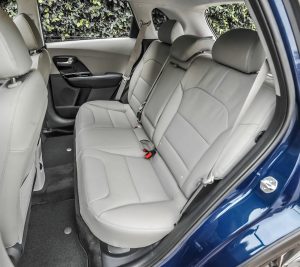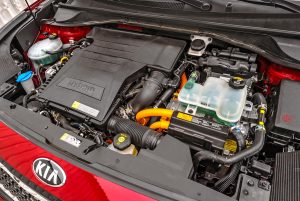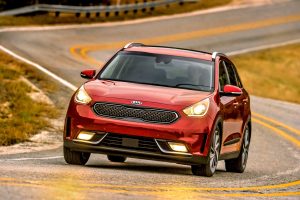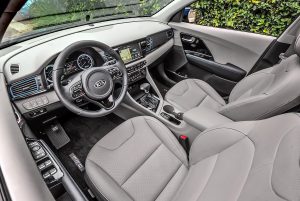The 2017 Kia Niro represents the brand’s first toe in the water with a dedicated hybrid model to take on the Toyota Prius. In our first test drive, we’ve found a formidable foe with a different take that sets it apart.
Called a crossover, the Kia Niro shares a footprint similar to that of the Toyota Prius but offers a taller silhouette, a higher seating position with a more SUV-like outward view, and significantly more interior space.
A deliberate hand was taken by Kia designer Mike Torpey to make the Niro look tough and rugged like a crossover and less the cheese sliced in-your-face presentation some hybrid cars bring to the game to scream at the world you have one.
Instead the Kia Niro has a muscular shape with a high shoulder line, emphasized wheel arches by way of lower black cladding. A roofline that’s formal with just enough rake to make it sporty is anchored by a sleekly wedged set of LED tail lamps.
Up front you have Kia’s “tiger nose” grille with good amount of detail in its pattern along with some diamond shaped LED headlamps. The lower fascia features handsome trim details and more of the black lower cladding that says crossover.
When it came to the interior Kia set out to continue the non-hybrid hybrid theme by creating a cabin devoid of the science experiment design ethos of joysticks and center mounted instrument clusters for something more mainstream.
Here you will find a very traditional horizontal dash layout and combination of trims, yet plenty of high-tech features to be competitively modern. Our top-line Touring tester had the 8-inch touchscreen infotainment and navigation system.
Its screen was easy to see and use even in direct sunlight. Graphics and menus are thoughtfully laid out and the energy monitor as always is much fun to watch. Audio from its eight-speaker Harman Kardon sound system is phenomenal. Even with the sub woofer thumping it, the trims and panels didn’t join the chorus.
The instrument cluster itself features a full function 4.2” TFT center screen between two round dials that looks all the part of tech while providing multiple choices of information. The steering wheel, heated in our tester was also well lined with various controls.
Heated leather seating in the Niro Touring was of high comfort. With memory settings for the driver, a power seat has 10-ways of adjustment. They are firm but remained comfortable on our long day of driving. The passenger seat remains manually adjustable.
 At the rear, passengers will enjoy a rather high seating position afforded by the crossover design format. Legroom and headroom are both commendable and compared to Prius, not even in the same ballpark.
At the rear, passengers will enjoy a rather high seating position afforded by the crossover design format. Legroom and headroom are both commendable and compared to Prius, not even in the same ballpark.
The hybrid battery pack is mounted below that rear seat which does fold down in a 60/40 split for a near flat load floor in spite of it. Under this floor you won’t find a spare tire however but an emergency inflator. There is room for a spare though, should you absolutely need one.
And that gets us to the drive. Powering the 2017 Kia Niro is a 104 horsepower 1.6 liter Atkinson Cycle direct-injected four-cylinder engine mated to a six-speed dual-clutch transmission. Between them is a 43 horsepower electric motor – all driving exclusively the front wheels.
With the use of a dry clutch to disconnect from the gasoline engine, the Niro can motor along on electric only power, gasoline only power or a combination of both with a maximum system horsepower of 139. Maximum torque however is 195 pound-feet which is what you really feel.
 The use of the six-speed dual-clutch transmission is a major contributor to the Niro’s distinctly non-hybrid driving character. As most hybrids use a continuously variable transmission, they often aren’t all that engaging. With a sport mode and a heavy foot, the Niro can feel downright fun on a windy back road.
The use of the six-speed dual-clutch transmission is a major contributor to the Niro’s distinctly non-hybrid driving character. As most hybrids use a continuously variable transmission, they often aren’t all that engaging. With a sport mode and a heavy foot, the Niro can feel downright fun on a windy back road.
Engine noise is very muted even when it’s working hard and the transition between gasoline and electric power is hardly noticeable. There is a short lag off the line but in Sport Mode a 0-60 time of 9.8 seconds was achieved thanks to Alex Dykes of Alex on Autos and his vBox.
Fuel economy is rated as high as 52 mpg city for the base models but drops steadily as you climb the trim grades to Touring due to more weight and larger tire sizes. Our Touring tester was rated at a still impressive 51 mpg city, 46 mpg highway, and 49 mpg combined.
In our day of driving we saw averages of 51 mpg on slower back road segments and 46 mpg on higher speed highway segments. Though not scientific measures, pretty accurate to ratings.
 Handling is the other major area where the Niro stands apart from many you could compare. It had a suspension athletic enough to let you push it confidently on a winding back road without getting white knuckles.
Handling is the other major area where the Niro stands apart from many you could compare. It had a suspension athletic enough to let you push it confidently on a winding back road without getting white knuckles.
On the flip side we found on rougher roads with a lot of undulations, the suspension was not only compliant enough to quell the roughness but the additional suspension travel of the crossover format enabled more ability to soak it up before hitting bump stops. Win win.
Stepping back and thinking of the big take away from our first drive, Kia has launched a great option to those who want a hybrid for fuel economy but hate how hybrids have looked and driven. The Kia Niro looks like and behaves like an everyday compact crossover like the Honda HR-V or the Mazda CX-3.
It gets fuel economy like some of the best dedicated hybrid cars out there however. And for those wanting more, Kia has said a plug-in hybrid variant will be along later for the 2018 model year.
Bottom line, we think they have winner here and it’s on sale now across North America starting at $22,890 for the entry level FE ranging up to $29,650 for the Touring we tested here. We’ll bring a far more detailed review soon when we get one for a full test.
































